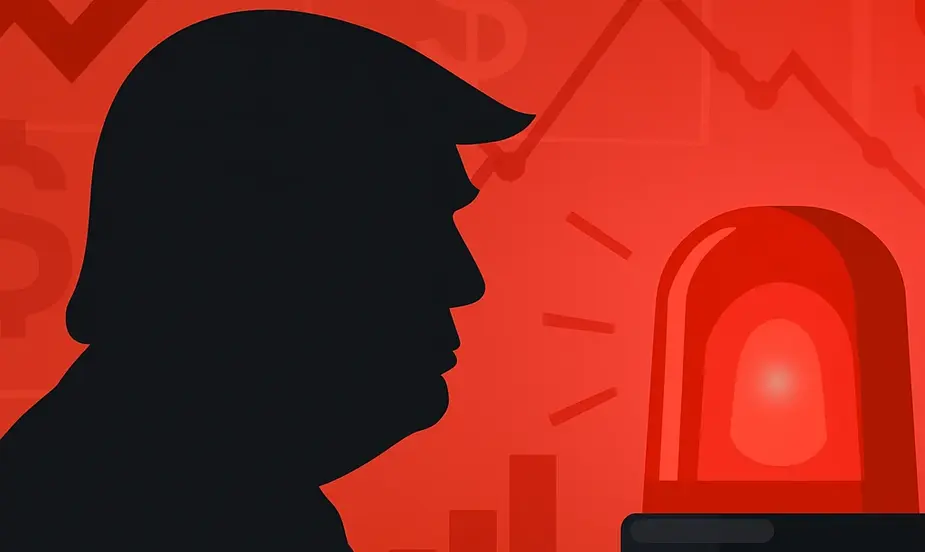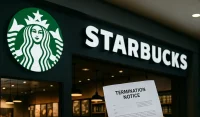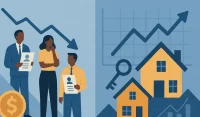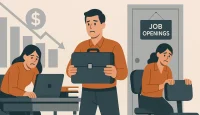Trump economy warning signs for USA, flash red light for the president as nine months into Donald Trump’s second term, the economic data reveals troubling contradictions that could threaten his political standing. With 81% of Americans who voted for Trump citing the economy as their primary concern, the current economic indicators present a complex picture of boom and bust that affects different segments of the population unequally.
The warning signs are stark: unemployment rates have climbed to 4.3% nationally and 10.5% for young Americans aged 16-24, creating what economists call a “no firing, no hiring” economy. Just 22,000 jobs were added in August, while new government data shows employers created nearly 1 million fewer jobs over the past year than previously reported.
Meanwhile, tariffs have sharply raised prices for everyday essentials, with ground coffee jumping from $6.31 to $8.87 per pound – a 33% increase. The overall US tariff rate on imports sits at 19.5%, affecting everything from coffee and bananas to TVs and toys. Economists on both the right and left agree these price pressures will only worsen.
Yet the stock market continues its remarkable run, hitting 28 record highs this year, boosted by AI promises and corporate profitability. Small business confidence is spiking, and the economy grew at nearly 4% in the second quarter. These contradictions create a confusing economic landscape that defies simple analysis.
The Employment Crisis: A “No Firing, No Hiring” Economy
The employment situation presents one of the most concerning Trump economy warning signs, with young Americans facing unprecedented challenges in the job market. The 10.5% unemployment rate for those aged 16-24 represents a significant barrier to economic mobility and career development.
The “no firing, no hiring” dynamic reflects corporate uncertainty about future economic conditions. Companies are maintaining their current workforce to avoid losing valuable employees, but they’re hesitant to add new positions, particularly entry-level jobs that young people typically need to start their careers.
Long-term unemployment has reached its highest level since the pandemic, with a greater share of college-educated people among those out of work for six months or longer. This represents a significant waste of human capital and creates lasting economic scars for affected individuals and families.
The employment crisis particularly affects college graduates seeking their first jobs. Companies, uncertain about future economic conditions and tariff impacts, are reluctant to hire entry-level positions while maintaining their existing workforce. This creates a bottleneck that prevents young people from entering the workforce and gaining valuable experience.
The Employment Crisis
With youth unemployment at 10.5% and companies reluctant to create new roles, young Americans face unprecedented challenges. Employers can break the cycle by opening doors for entry-level talent and shaping the workforce of tomorrow. Post your job on WhatJobs today and connect with ambitious graduates ready to make an impact.
Post a Job Free for 30 Days →The Tariff Impact: 33% Price Increases and Rising Costs
The tariff policies represent another major Trump economy warning sign, with the 19.5% overall tariff rate on imports creating significant price pressures for American consumers. The impact extends far beyond the headline 33% increase in coffee prices to affect virtually every aspect of household budgets.
Essential goods and services have seen dramatic price increases over the past five years: auto insurance up 60%, shelter costs up 50%, electricity up 38%. These are expenses that families cannot avoid or substitute, creating a persistent squeeze on household finances that makes economic recovery feel distant.
The tariff impact creates a particularly challenging situation for businesses, which must decide whether to pass increased costs on to consumers or absorb them internally. Many companies are choosing to absorb tariff costs rather than risk losing customers who are already struggling with high prices.
The agricultural sector faces particularly severe challenges, with Chinese tariffs on American soybeans forcing farmers to store crops or find alternative markets. The loss of the Chinese market for soybeans represents a significant economic blow to rural communities that supported Trump’s election.
The Stock Market Paradox: Record Highs Amid Economic Uncertainty
The stock market’s performance presents one of the most puzzling Trump economy warning signs, with 28 record highs this year despite underlying economic challenges. This disconnect between Wall Street and Main Street reflects the concentration of market gains in a handful of large technology companies.
The S&P 500’s performance is largely driven by seven major tech stocks that have benefited from AI investment and market enthusiasm. These companies have figured out how to maintain profitability despite economic headwinds, often by absorbing tariff costs rather than passing them on to consumers.
The concentration of gains in a few large companies means that most Americans don’t benefit from the stock market’s performance. While 401(k) accounts may show gains, the broader economy continues to struggle with employment, inflation, and economic uncertainty.
The AI investment boom has created significant market enthusiasm, but the technology has yet to deliver on its promised productivity gains. Companies are investing heavily in AI capabilities, but the actual impact on job creation and economic growth remains uncertain.
The Consumer Debt Crisis: Living on Credit
Consumer debt represents another critical Trump economy warning sign, with Americans increasingly relying on credit to maintain their standard of living. Credit card debt at 20% interest rates, near record highs, creates a dangerous cycle of debt accumulation that threatens long-term economic stability.
The rise of “buy now, pay later” services reflects consumers’ desperate need for flexible payment options, but these services can trap users in cycles of debt when payments are missed. The fact that some consumers are using these services for groceries and takeout indicates severe financial stress.
Emergency savings have reached dangerously low levels, with 24% of Americans having no emergency savings at all. This means nearly one in four Americans is essentially living in a personal recession, one unexpected expense away from financial crisis.
The debt crisis is particularly concerning because it occurs during a period of relatively low unemployment and economic growth. This suggests that the economic recovery has not been broadly shared, leaving many Americans struggling to make ends meet despite positive macroeconomic indicators.
The Consumer Debt Crisis
With credit card debt near record highs and 1 in 4 Americans lacking emergency savings, financial stress is reshaping the economy. Employers can play a role in restoring stability by creating opportunities that provide income security and growth. Post your job on WhatJobs today and connect with candidates eager for financial stability and a brighter future.
Post a Job Free for 30 Days →The Business Community’s Dilemma: Adapting to Uncertainty
The business community’s response to Trump’s economic policies reveals another layer of Trump economy warning signs, with companies struggling to adapt to an uncertain regulatory and trade environment. The constant threat of new tariffs and policy changes makes long-term planning extremely difficult.
Many businesses are choosing to absorb tariff costs rather than pass them on to consumers, recognizing that customers are already stretched thin financially. This strategy may be sustainable in the short term, but it’s unclear how long companies can maintain profitability while absorbing increased costs.
The agricultural sector faces particularly severe challenges, with farmers losing traditional markets due to retaliatory tariffs. The shift from Chinese to Brazilian soybeans represents a permanent loss of market share that will be difficult to recover even if tariffs are eventually removed.
Business leaders are divided on whether the current economic policies represent a permanent shift or a temporary disruption. Some believe tariffs are here to stay and are adapting their business models accordingly, while others are waiting for the next administration to provide relief.
Frequently Asked Questions
Trump economy warning signs flash red light for the president – what are they?
Trump economy warning signs flash red light for the president include rising unemployment (4.3% overall, 10.5% for young people), 33% price increases from tariffs, consumer debt crisis, and economic contradictions despite stock market highs.
Why is unemployment rising despite economic growth?
Unemployment is rising due to a “no firing, no hiring” economy where companies maintain current workers but avoid adding new positions due to uncertainty about tariffs, trade policies, and future economic conditions.
How are tariffs affecting American consumers?
Tariffs have raised the overall US tariff rate to 19.5%, causing 33% price increases on essentials like coffee, with auto insurance up 60%, shelter costs up 50%, and electricity up 38% over five years.
Why is the stock market hitting record highs despite economic problems?
The stock market’s gains are concentrated in seven major tech companies benefiting from AI investment, while most Americans don’t benefit from these gains and continue struggling with high costs and debt.
What is the consumer debt crisis?
The consumer debt crisis includes credit card debt at 20% interest rates, 24% of Americans with no emergency savings, and increasing reliance on “buy now, pay later” services for basic expenses like groceries.
How are businesses responding to economic uncertainty?
Businesses are absorbing tariff costs rather than passing them to consumers, struggling with long-term planning due to policy uncertainty, and divided on whether current policies represent permanent change or temporary disruption.
A Real-World Example: The Midwest Farmer’s Struggle
John Peterson, a soybean farmer in Iowa, exemplifies the Trump economy warning signs that are affecting rural America. “I’ve been farming for 30 years, and I’ve never seen anything like this,” he explains. “The Chinese used to buy 60% of our soybeans, but now they’re buying from Brazil and Argentina because of the tariffs.”
Peterson’s farm, which has been in his family for generations, is facing an existential crisis. “I have soybeans sitting in the field that I’m not sure are worth harvesting,” he says. “The cost of fuel, equipment, and labor might be more than what I can get for the crop.”
The economic impact extends beyond Peterson’s farm to the entire rural economy. “The local equipment dealer is struggling because farmers aren’t buying new machinery,” he explains. “The grain elevator is half-empty because there’s no market for our crops. It’s affecting everyone in the community.”
Despite these challenges, Peterson remains a Trump supporter. “I believe in what he’s trying to do,” he says. “I know he’s promised us subsidies to make up for the lost markets, and I’m willing to wait it out. But I don’t know how long we can hold on.”
Peterson’s experience illustrates the complex relationship between economic reality and political support. “The Democrats don’t have a better plan,” he says. “At least Trump is trying to do something different. The old way wasn’t working for us either.”
The long-term implications of Peterson’s situation are concerning. “If we lose these markets permanently, it’s going to be hard to get them back,” he explains. “Once a customer switches suppliers, they don’t usually come back. This could change farming in America forever.”
Peterson’s story highlights the broader economic challenges facing rural America and the difficult choices that farmers must make in an uncertain economic environment. “We’re all just trying to survive,” he says. “I hope the president’s plan works, but I’m not sure how much longer we can wait.”
Don’t Ignore the Economic Warning Signs
The Trump economy warning signs represent a complex web of interconnected challenges that threaten both individual financial security and broader economic stability. While the stock market’s performance and some positive economic indicators may provide temporary reassurance, the underlying structural problems cannot be ignored.
The combination of rising unemployment, increasing consumer debt, and the impact of tariffs on everyday expenses creates a perfect storm of economic challenges that could lead to significant social and political instability. The fact that these problems are affecting the very voters who supported Trump based on economic promises makes them particularly concerning.
The economic contradictions highlight the need for a more comprehensive approach to economic policy that addresses both short-term challenges and long-term structural issues. Simply relying on stock market performance or isolated economic indicators provides a misleading picture of the true state of the economy.
The future of American prosperity depends on addressing these warning signs before they become full-blown crises. The time for action is now, before the economic contradictions become too severe to manage effectively.




